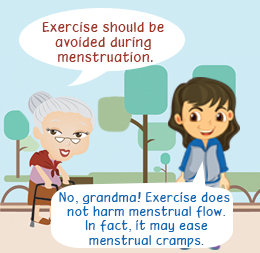Menstruation: A myth that needs to be broken

Ayesha Mehrotra is pursuing her undergraduate degree in Bangalore. She is passionate about the environment and various social issues. Through her writing at this platform, she hopes to encourage the millions of unheard voices to speak out.
Menstruation: A myth that needs to be broken
With the Sustainable Development Goals playing an important role in our daily lives, it is important to address the various issues and solve them so that people can lead a better, healthier, and happy life.
‘SDG-3 aspires to ensure health and well-being for all, including a bold commitment to end the epidemics of AIDS, tuberculosis, malaria and other communicable diseases by 2030. It also aims to achieve universal health coverage and provide access to safe and effective medicines and vaccines for all. Supporting research and development for vaccines is an essential part of this process as well as expanding access to affordable medicines.’
The topic that is most avoided and causes poor health choices for women across the world, is menstruation. It is something which needs to be taken seriously and awareness is an important factor in inculcating a better environment for all women.
Menstruation is a phenomenon unique to girls. However, it has always been surrounded by taboos and myths that exclude women from many aspects of socio-cultural life. In India, this has been an ‘unholy’ or ‘dirty’ subject of conversation till date. Such taboos about menstruation present in many societies an impact on girls’ and women’s emotional quotient, mentality, lifestyle and most importantly, health. The challenge of addressing the socio-cultural myths and beliefs in menstruation is further triggered by less knowledge and understanding of puberty, menstruation, and reproductive health among girls at large. Thus, there is a need to imbibe a strategic approach in combatting these issues.
In ‘Modern India’, as we call it, even broaching this topic has been a taboo in the past. To this date, the cultural and social influences appear to be a hurdle for advancement. In religious gatherings, women are prohibited from participating in normal life while menstruating. She must be “purified” before she is allowed to return to her family and day-to-day chores of her life. As we all know that there is obviously a scientific explanation to everything. The actual cause of menstruation is ovulation followed by missed chance of pregnancy that results in bleeding from the endometrial vessels and is followed by preparation of the next cycle.
In some parts of India, perceptions of Hinduism center on notions of purity and pollution. Bodily excretions are believed to be polluting, as are the bodies when producing them. All women, regardless of their social caste, incur pollution through the bodily processes of menstruation and childbirth.
Large numbers of girls in many less economically developed countries drop out of school when they begin menstruating. This includes over 23% of girls in India. In addition to this, the monthly menstruation period also creates obstacles for female teachers. Thus, the gender – unfriendly school culture and infrastructure and the lack of adequate menstrual protection alternatives and/or clean, safe and private sanitation facilities for female teachers and girls undermine the right of privacy. There are health and hygiene issues also to consider relating to girls and menstruation. Over 77% of menstruating girls and women in India use an old cloth, which is often reused. Further, 88% of women in India sometimes resort to using ashes, newspapers, dried leaves and husk sand to aid absorption. Poor protection and inadequate washing facilities may increase susceptibility to infection, with the odor of menstrual blood putting girls at risk of being stigmatized. The latter may have significant implications on their mental health.
Based on the available facts and figures, it is important to implement a strategic approach to combatting the myths and social taboos associated with menstruation in order to improve the reproductive health of adolescent girls and women. The first and foremost strategy in this regard is raising the awareness among the adolescent girls related to menstrual health and hygiene. Young girls often grow up with limited knowledge of menstruation because their mothers and other women shy away from discussing the issues with them. Adult women may themselves not be aware of the biological facts or good hygienic practices, instead passing on cultural taboos and restrictions to be observed. Community-based health education campaigns could prove worthwhile in achieving this task. There is also need to spread awareness among the school teachers regarding menstruation.
Encouraging women through education and increasing their role in decision-making can also aid in this regard. Increasing the education status of women plays an important role in improving the health status of the community at large and overcoming the cultural taboos, in particular. Provision of sanitary napkins and adequate facilities for sanitation and washing should be made available with the gender perspective.
Low-cost sanitary napkins can be locally made and distributed particularly in rural and slum areas as these are the areas where access to the product is difficult. The government of India has approved a scheme to improve menstrual hygiene for 1.5 Crore adolescent girls by distributing low-cost sanitary napkins in rural areas under the National Rural Health Mission since 2010. However, the scheme is in the initial phase, a lot more needs to be achieved in this regard. Increasing the role of the male partner and clearing the beliefs system of the male partner is also pertinent in combating deep-rooted social beliefs and cultural taboos. Men and boys typically know even less, but it is important for them to understand menstruation so they can support their wives, daughters, mothers, students, employees, and peers. As far as exercise is concerned, many studies in India and elsewhere have revealed that many adolescent girls believe that doing exercise/physical activity during menses aggravate the dysmenorrhea (painful cramps) while in real exercise can help relieve the menstruating women with symptoms of premenstrual syndrome and dysmenorrhea and relieve bloating. Exercise also causes a release of serotonin, making one feel much happier.
Sensitization of health workers, regarding menstruation biology must also be done so that they can further disseminate this knowledge in the community and mobilize social support against busting menstruation related myths. They must also have trained manpower to address these issues.
Thus, it is becoming clear that multi-sectoral approaches and support is required. We need to link physical infrastructure and water and sanitation projects to health education and reproductive health programs and address the issue in more holistic ways. India is progressing, though there is a stringent requirement for improvement in these areas.


